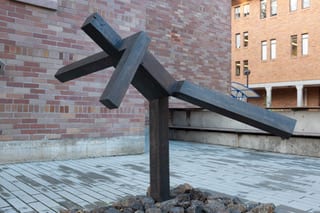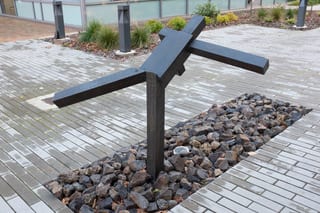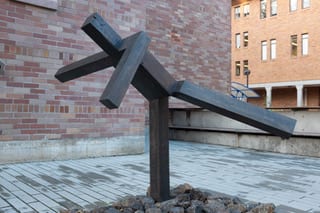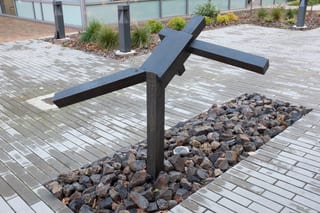Joel Shapiro was born on September 27, 1941 in Queens, New York. He attended New York University where he earned a BA in 1964 and MA in 1969. He is an artist of international prominence who specializes in creating sculptures that abstract the human form. The piece we are examining in particular was created by Shapiro later in his career, but was heavily influenced by the art world of his earlier years as an artist.
Shapiro has created numerous works of art that are displayed internationally. According to the Pace Gallery he has, “executed more than 30 commissions… and has been the subject of more than 160 solo exhibitions.” On top of this, Shapiro has received multiple awards and accolades, “including an Award of Merit Medal for Sculpture given by the American Academy and Institute of Arts and Letters, NY (1990); Skowhegan Medal for Sculpture (1986); Brandeis University Creative Arts Award (1984); and the Visual Art Fellowship from the National Endowment for the Arts (1975),” (Berggruen Gallery).
Before he received his degrees from New York University, he spent two years in India serving the Peace Corps. His time in India inspired him to pursue becoming an artist. His inspiration also stems from the minimalist movement of the 1960’s when he was coming into his own as an artist. But Shapiro was not interested in following the artists of this time. According to a biography of Shapiro on Artnet he was, “Inspired by prominent Minimalist sculptors such as Carl Andre, Donald Judd, and Richard Serra, Shapiro extrapolates their aesthetic into works that are more colorful and playful that those of his peers.” He also pushes the boundaries of minimalism by using minimalist techniques to explore the human figure. The minimalism movement often rejected the human figure, but the majority of Shapiro’s work combines the two concepts.
The specific piece of his that we are exploring is Untitled by Joel Shapiro and is located outside of the Carver Academic Building here at Western Washington University. It is a prime example of his work blending together the human form with minimalism. This piece was created in the 1980’s which was during the postmodernism movement in the art world. Postmodernism appears to have influenced this piece as it seems to build off of the concept of deconstruction which many artists of this time employed. The piece breaks down the human figure into perhaps the simplest form it could take.
This work, like many of Shapiro’s pieces, explores the ability of the art to challenge the viewers perception of it. “Joel Shapiro has built his sculptures out of wood, wire, and cast bronze, relying on space and the position and proximity of the viewer to play with perception,” (Artsy). He created a simple piece that would become more than a stagnant piece of art. His intent behind Untitled #9 was to “describe an emotional state, my own longing and desire.”. The minimalist nature of it allows space for the piece to interact with the environment surrounding it. Also, it allows the viewer to see the art piece in a different way each time they interact with it.
Combining minimalism with the human form was a simple yet daring concept that Shapiro offered the world of art when few were doing such a thing. This piece is a prime example of the unique body of work that he has created throughout his career.
Max Van Dam – Research/Coordinator
Sarah McCauley – Research/Wordpress
Matthew Marinez – Head Photographer
Bibliography
“Joel Shapiro.” Artsy. https://www.artsy.net/artist/joel-shapiro.
“Joel Shapiro.” Paula Cooper Gallery. https://www.paulacoopergallery.com/artists/joel-shapiro/selected-works.
“Joel Shapiro.” Berggruen Gallery. http://www.berggruen.com/artists/joel-shapiro.
“Joel Shapiro.” Pace Gallery. https://www.pacegallery.com/artists/434/joel-shapiro.
“Joel Shapiro.” Artnet. http://www.artnet.com/artists/joel-shapiro/.
Klein Gerber, Michele and Joel Shapiro. “Joel Shapiro.” BOMB, no. 109, 2009, pp. 30–37. JSTOR, JSTOR, www.jstor.org/stable/27944605.
Rapaport, Brooke Kamin. “Joel Shapiro: Meaning in Geometric Form”
Sim, Stuart. The Routledge Companion to Postmodernism. Routledge, 2002.
Shapiro, Joel. “Joel Shapiro: Recent Sculptures and Drawings: April 27 – May 26.” New York : PaceWildenstein, 2001.






Leave a Reply